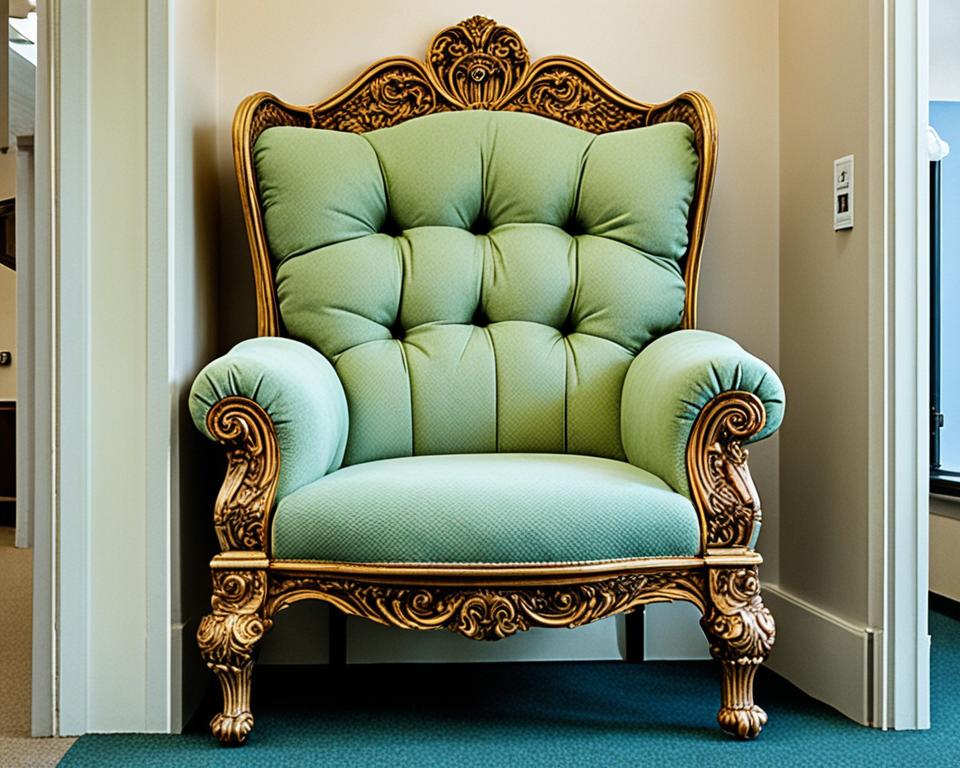When a loved one joins a nursing home, ensuring their safety and well-being becomes our utmost priority. While it’s natural to bring personal items to make their new space feel like home, there are certain items that should be left behind.
But have you ever wondered what these forbidden items are? Are there specific reasons behind their prohibition? Let’s explore the items that are not allowed in nursing homes and why they matter for the comfort and security of the residents.
Throw Rugs and Mats
When considering the items to bring to a loved one’s new nursing home, throw rugs and mats should be left at home. These items may add a stylish touch to the decor, but they can also pose a significant tripping hazard for residents, especially those who have undergone physical rehabilitation or experience difficulty getting around.
Trips and falls are a common concern in nursing homes, and throw rugs and mats, though seemingly harmless, can contribute to these accidents. These floor coverings have the potential to shift or bunch up, creating an uneven surface that increases the likelihood of tripping. This is particularly risky for individuals who have limited mobility or rely on assistive devices like walkers or canes.
Residents who have recently undergone physical rehabilitation may still be adjusting to their new level of mobility and may require additional support when moving around. The presence of throw rugs and mats can impede their progress and increase the risk of falls, potentially resulting in injuries that may setback their progress in physical rehabilitation.
Furthermore, aging can bring about changes in vision, making it more challenging for individuals to detect changes in the floor surface or navigate safely through their environment. By eliminating throw rugs and mats, nursing homes can reduce the tripping hazard and create a safer living space for their residents.
Collectables and Figurines
While hobbies are encouraged in nursing homes, it’s important to consider the limited space available. If your family member collects items such as figurines as part of their hobby, there may not be enough room to house the entire collection. It’s a good idea to offer to store the collectables or choose a few favorite pieces to keep on display.
Many residents find joy and fulfillment in pursuing hobbies during their stay in nursing homes. Hobbies like collecting figurines and other collectables can bring a sense of nostalgia and personal enjoyment. However, it’s essential to consider the available space within the resident’s room and the overall safety of the environment.
Figurines and collectables can vary in size and number, and while they hold sentimental value, accommodating an extensive collection may not always be feasible. Nursing home rooms are designed to provide a comfortable living space for residents while considering safety and accessibility.
Instead of overcrowding the limited space with an entire collection of figurines, it’s advisable to select a few favorite pieces that have significant meaning or sentimental value. Choose items that will bring joy to your loved one without overwhelming the room’s limited space.
Another option is to offer to store the additional collectables in a safe and secure location outside of the nursing home. This ensures that the treasures are protected and can be rotated for display when desired. Alternately, you can explore the possibility of donating the excess items to a local museum or charity where they can be appreciated by a wider audience.
Benefits of Selective Display:
- Preserving cherished memories: By carefully choosing a few favorite figurines, you can create a display that reminds your family member of cherished memories and experiences.
- Reducing clutter: Limited space calls for careful consideration of what items are most important. By opting for a selective display, you can prevent the room from becoming cluttered and ensure a comfortable living environment.
- Promoting safety: Minimizing the number of collectables reduces the risk of accidental falls or damage due to overcrowding. Safety is a top priority in nursing homes, and by being mindful of space limitations, you contribute to a safer living environment for your loved one.
Remember, the purpose of displaying collectables and figurines is to enhance the resident’s living space, not overwhelm it. By carefully selecting a few meaningful pieces and considering the limited space available, you can create a display that brings joy and comfort to your loved one while maintaining a safe and clutter-free environment.
Large Furniture
When it comes to furnishing a nursing home room, it’s important to consider the size and impact of the items being brought in. While large furniture is not necessarily banned, it usually requires preapproval from the nursing home administration. This is because large pieces of furniture can potentially interfere with care or violate fire code standards.
Before bringing in any large furniture, it’s crucial to check with the nursing home to ensure compliance with their guidelines. This proactive step helps avoid any potential issues or conflicts down the line.
Large furniture items such as oversized sofas, heavy dressers, or large entertainment centers may be too bulky for the limited space available in a nursing home room. These pieces can be difficult to maneuver around, potentially hindering the movement of residents and caregivers.
Furthermore, fire code standards are put in place to ensure the safety of everyone in the facility. Large furniture pieces can obstruct fire exits or impede the flow of movement during emergencies. Complying with these standards is essential to maintain a safe living environment for all residents.
By obtaining preapproval and adhering to the specific guidelines of the nursing home, families can make informed decisions about the furniture they bring into their loved one’s new living space.
| Pros of large furniture in nursing homes | Cons of large furniture in nursing homes |
|---|---|
|
|
While large furniture can have its benefits, it’s crucial to consider the potential drawbacks when furnishing a nursing home room. Prioritizing the safety and well-being of the resident should always be the top priority.
Duplicate Items
When it comes to living in a nursing home, space can be limited. It’s important to eliminate any duplicate items to maximize the available storage space and ensure a clutter-free environment for residents. By getting rid of unnecessary duplicates, residents can create a more organized and comfortable living space.
Duplicate items can include things like extra sets of bedding, multiple sets of dishes, or duplicate clothing items. While it may be tempting to bring these items for convenience, it’s best to prioritize the essential items and eliminate any duplicates.
Having duplicate items can make it challenging to find what you need, creating unnecessary clutter and confusion. By simplifying and streamlining their possessions, residents can make their living space more functional and enjoyable.
Additionally, eliminating duplicate items can help residents stay organized and reduce the likelihood of misplacing or losing things. It can make it easier to keep track of personal belongings and maintain a tidy living space.
It’s worth noting that certain facilities may have specific storage limitations or guidelines regarding duplicate items. It’s important to check with the nursing home administration to understand any restrictions or recommendations they may have.
By being mindful of storage limitations and taking steps to eliminate duplicate items, residents can create a more comfortable and organized living space in their nursing home.
| Benefits of Eliminating Duplicate Items |
|---|
| 1. Maximizes storage space: Eliminating duplicates frees up storage areas for more essential items. |
| 2. Reduces clutter: Getting rid of unnecessary duplicates creates a more organized living environment. |
| 3. Easier to locate belongings: With fewer duplicate items, residents can find what they need more quickly and easily. |
| 4. Enhances organization: Eliminating duplicates helps residents maintain a tidy and well-organized living space. |
Restricted Items for Safety
When it comes to the safety of residents in nursing homes, certain items are restricted. These restrictions are put in place to prevent accidents, maintain a secure environment, and prioritize the well-being of everyone living in the facility. Let’s take a look at the items that are typically not allowed.
Chairs on Wheels
Chairs on wheels may seem convenient, but they can pose a falling or tripping hazard in a nursing home setting. To ensure the safety of residents, these chairs are generally restricted. It’s important to prioritize stability and prevent any accidents that may result from unsteady chairs.
Seldom-Worn Jewelry
While nursing homes do allow residents to wear jewelry, large collections of seldom-worn jewelry are discouraged. The limited storage space and security concerns make it impractical to accommodate extensive jewelry collections. It’s best to choose a few favorite pieces that can be easily stored and secured.
Candles
Open flames from candles are not allowed within nursing homes for safety reasons. This is to prevent the risk of fire accidents and ensure the well-being of residents. However, alternative options like essential oils or flameless air fresheners can be considered to create a pleasant atmosphere without compromising safety.
Heat-Generating Items
Items that generate heat, such as space heaters and electric blankets, are typically not permitted in nursing homes due to fire hazards. These items can pose a serious risk and potentially lead to accidents or injuries. It’s important to prioritize safety by refraining from bringing such items into the facility.
Tools
Nursing homes have dedicated maintenance teams to handle repairs and maintenance tasks. As such, residents are not allowed to bring their own tools. This policy ensures that only qualified individuals handle any necessary repairs or maintenance in a safe and efficient manner.
Extensive Wardrobe
While it’s understandable to have a diverse wardrobe, nursing homes discourage residents from bringing an extensive wardrobe due to limited closet space. It’s important to be mindful of the available storage and choose essential clothing items that can fit comfortably without causing clutter.
| Restricted Items | Reason for Restriction |
|---|---|
| Chairs on Wheels | Falling or tripping hazard |
| Seldom-Worn Jewelry | Limited storage and security concerns |
| Candles | Safety risks and fire hazards |
| Heat-Generating Items | Fire hazard |
| Tools | Maintenance teams are available |
| Extensive Wardrobe | Limited closet space |
Conclusion
Ensuring the safety and well-being of residents in nursing homes is of utmost importance. Adhering to the prohibited item guidelines is crucial in creating a comfortable and secure living environment. By understanding which items are not allowed, families can actively contribute to the overall welfare of their loved ones.
Consulting with the nursing home administration is a necessary step to gain clarity on any specific requirements or preapprovals before bringing in items. This proactive approach helps to prevent any potential disruptions or risks to the residents’ safety.
Remember, nursing homes prioritize the well-being of their residents. By following the safety guidelines and respecting the prohibited items list, families can contribute to creating a supportive and thriving community within nursing home facilities.
FAQ
What items are not allowed in nursing homes?
Throw rugs and mats, large furniture (without preapproval), duplicate items, chairs on wheels, extensive wardrobe, seldom-worn jewelry collections, candles, heat-generating items, tools, and maintenance items are generally not allowed in nursing homes.
Why are throw rugs and mats not allowed in nursing homes?
Throw rugs and mats pose a tripping hazard, especially for residents who have undergone physical rehabilitation or have difficulty getting around.
Can I bring collectables and figurines to a nursing home?
While hobbies are encouraged, space limitations in nursing homes may not allow for the display of entire collectable or figurine collections. It’s best to offer to store them or choose a few favorite pieces to keep on display.
Do nursing homes allow large furniture?
Large furniture is not necessarily banned, but it usually needs to be preapproved. Certain pieces may be too bulky and can interfere with care or violate fire code standards. It’s important to check with the nursing home before bringing in large furniture.
Why should I eliminate duplicate items in a nursing home?
Nursing homes often have limited storage space, so eliminating duplicate items helps residents make the most of the available space without cluttering their rooms.
Are there any safety restrictions on items in nursing homes?
Yes, chairs on wheels can be unsteady and pose a falling or tripping hazard. Seldom-worn jewelry collections are discouraged due to limited storage and security concerns. Open flames from candles are not allowed for safety reasons, but alternatives like essential oils or flameless air fresheners can be considered. Heat-generating items like space heaters and electric blankets are not permitted due to fire hazards. Tools and maintenance items are unnecessary as nursing homes have maintenance teams. Lastly, an extensive wardrobe is discouraged due to limited closet space.
Why is it important to adhere to prohibited item guidelines in nursing homes?
Adhering to the prohibited item guidelines helps prioritize the safety and well-being of the residents. By understanding which items are not allowed, families can ensure a comfortable and secure living environment for their loved ones. It’s important to consult with the nursing home administration for any specific requirements or preapprovals before bringing in items.









